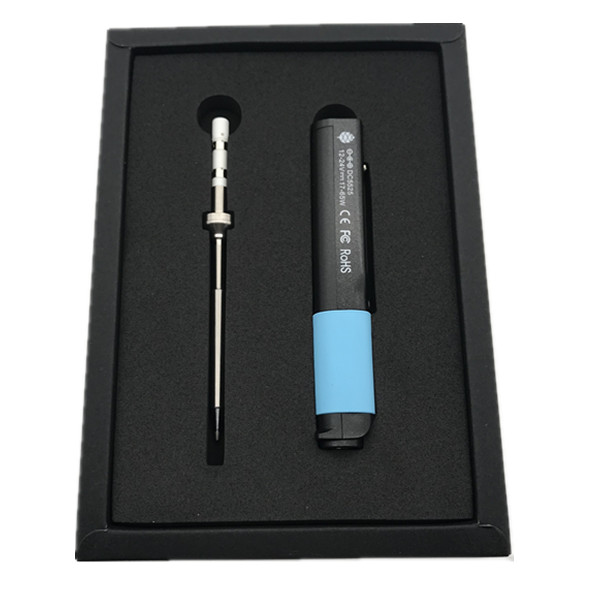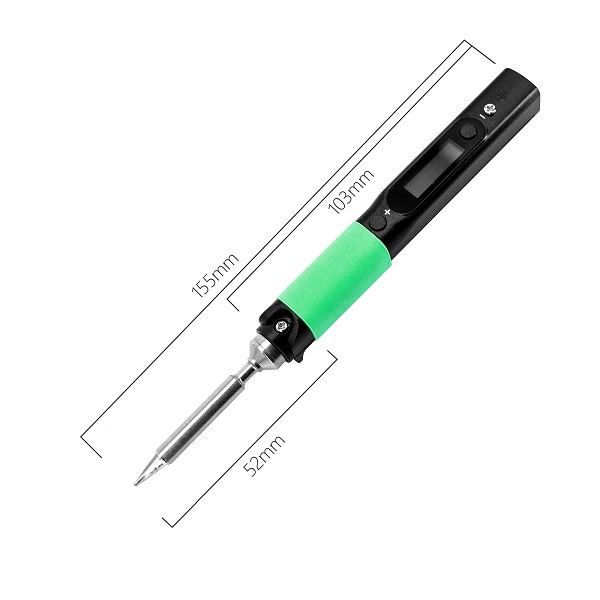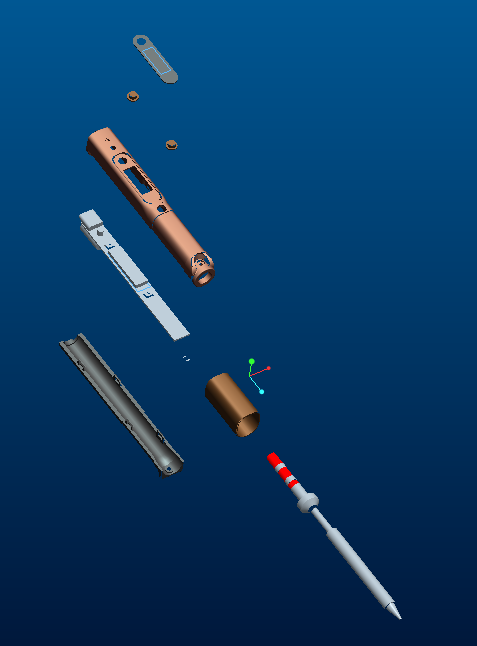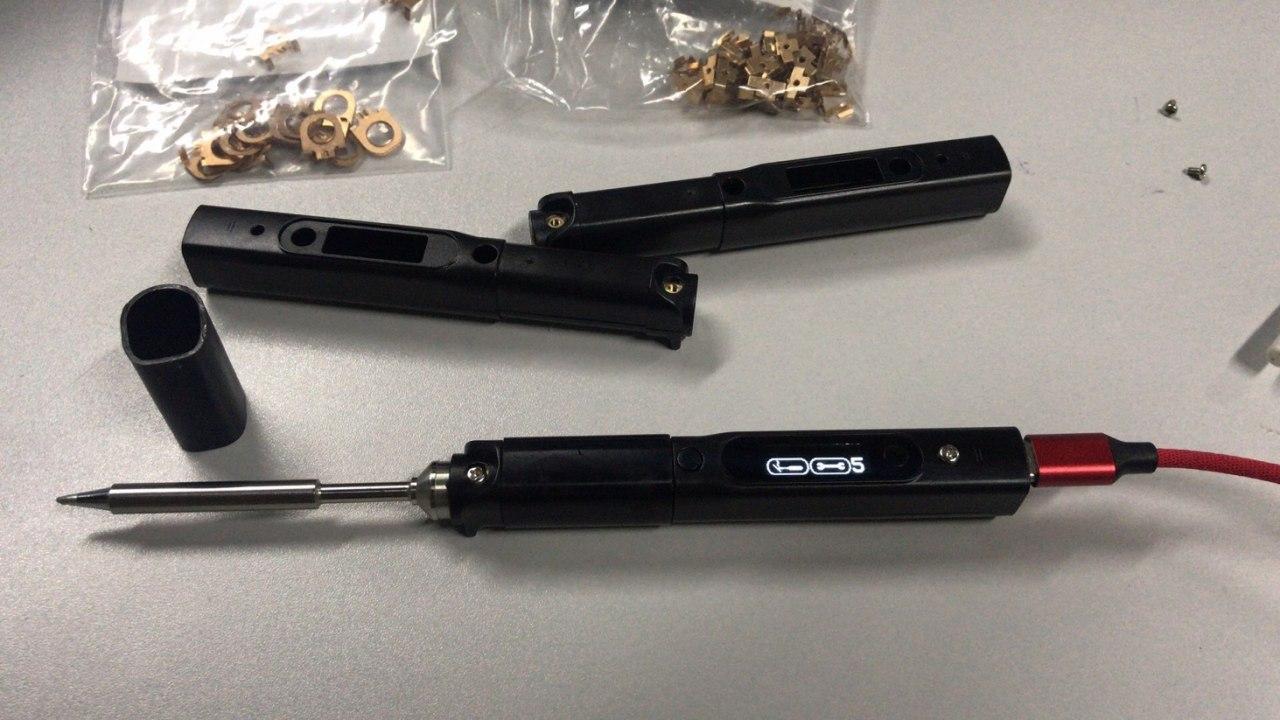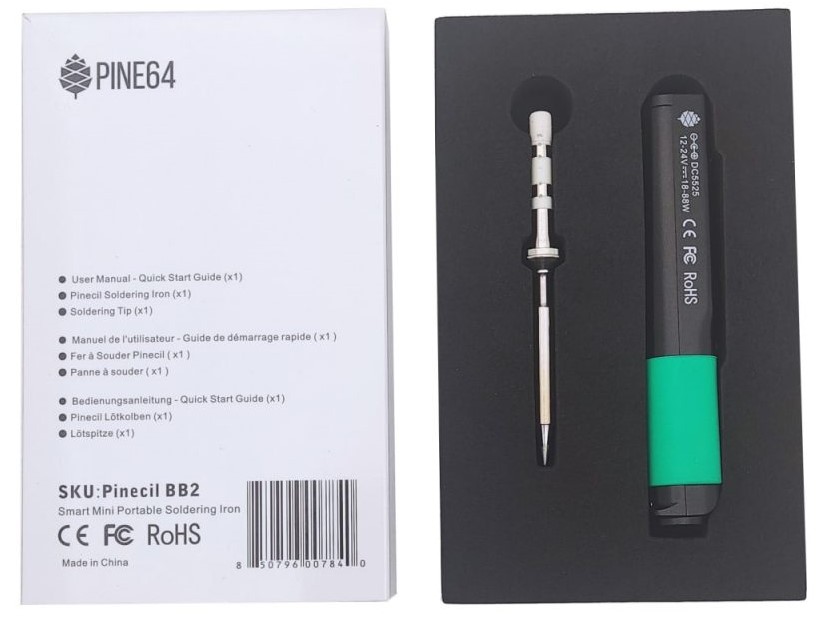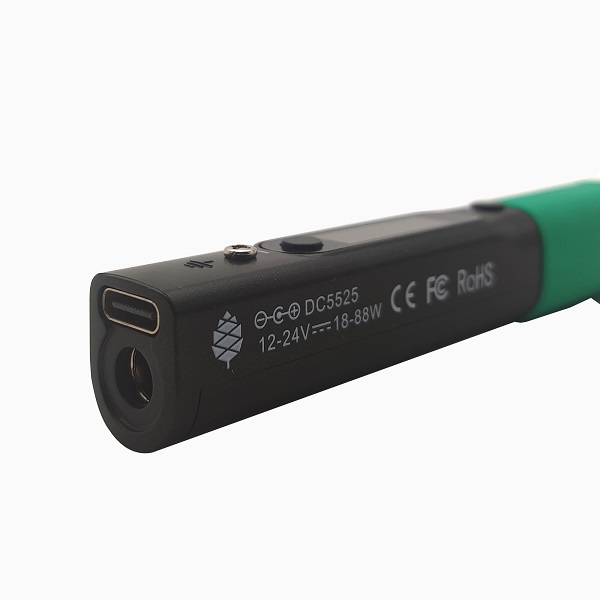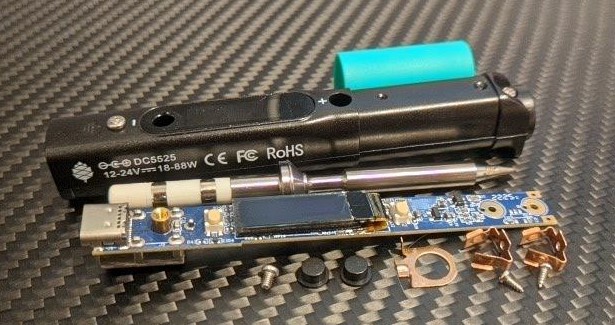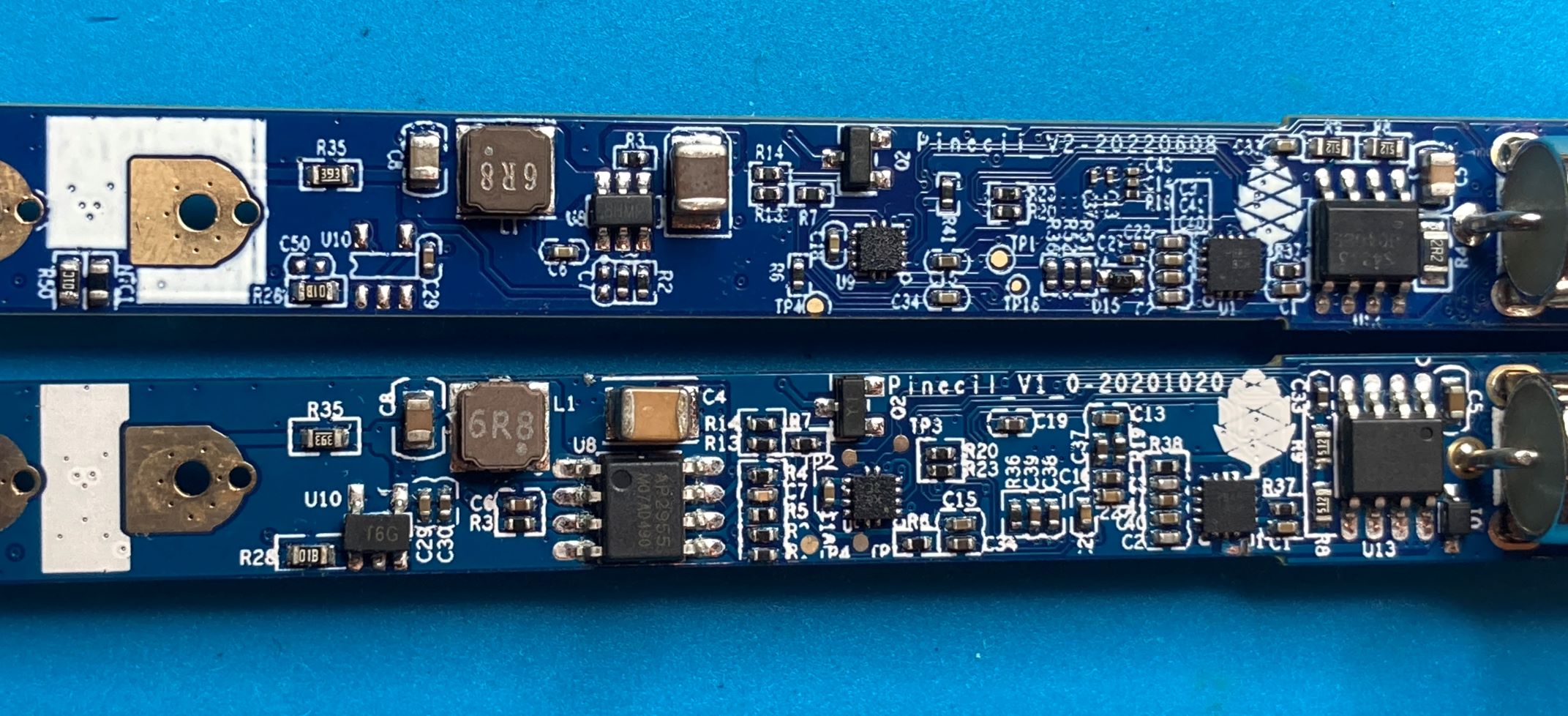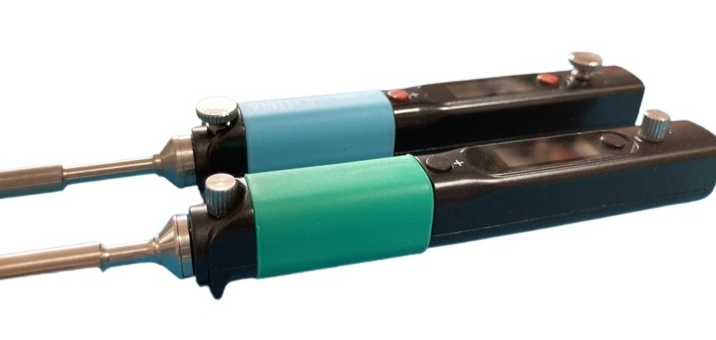Difference between revisions of "User:Liz 34/Pinecil"
| Line 15: | Line 15: | ||
| | | | ||
|} | |} | ||
== Timeline == | |||
==== V2 ==== | |||
* On Aug. 2, 2022, Pinecil V2 was released with improved hardware & accesories. It retains the same ergonomics and design as the original Pinecil, and will work with any accessories you already have including existing cases and tips. It comes with a green color silicone grip versus the light blue finger grip from Pinecil V1. It also includes one of Pine64's newly designed shorter 6.2 ohm tips. By reducing the tip resistance from 8 to 6.2 ohms, it allows greater performance and and faster heating (64W @ 20V compared to 8ohm tips which allowed a max of 50W to Pinecil). Pinecil V2 is rated for 12V-24V. | |||
* Key changes in V2: new processor (BL706), higher maximum input voltage (24V), tentative support for USB-PD3.1 EPR (28V), support for measuring tip resistance, allows automatic detection of 6.2 vs 8 ohm tips. A notable improvement is the new BL706 RISC-V processor from Bouffalo. It is similar to the BL602 in the Pinenut. The BL706 features Bluetooth Low Energy (BLE / Zigbee); future IronOS firmware releases will work to expose features over BLE. This is not trivial work, but as people contribute to the opensource code of Github/IronOS, the BLE will be expanded. | |||
* Things staying the same in V2: V2 still uses a RISC-V processor, but adds noticeable upgrades to the hardware. GPIO is broken out on USB-C for creating your own projects, same pinout as Pinecil V1, same great feel, including the rubber grip, works with all existing tips, same DC input + USB-C input connections, same case as V1 and compatibility with the clear or black handles. | |||
* In V2 labeling, the 88W figure comes from a 6.5ohm tip calculation. The reason for using 6.5 instead of 6.2 for the new short tips calculation is due to tolerance during manufacturing, and leaving a conservative margin of error (actual tips appear to be 6.2 ohms). V2 set max voltage is listed as 24V because this was the value used during design and component selection. | |||
==== V1 ==== | |||
* For the first manufacture batch (October 2020, order number 158xxx) of the Pinecil, the copper ring connecting the earth screw to the tip was omitted as the engineering team found the TS100 design lacking. For the second round onwards, an improved design copper ring has been included as standard, and is also included with the replacement clear and black handles. For normal operation of the iron, omission of the ring does not impact it's operation. '''If you are working with ESD components, you will need it in order to ground the iron tip via the earth screw at the back of the iron.''' | |||
* Programmable with [https://doc.nucleisys.com/nuclei_sdk/design/soc/gd32vf103.html tools from Gigadevice] | |||
* The first batch of Pinecil's were rated 12-24v @ 65W. After some heated discussion on the discussion group, it was decided that it would be downgraded to 12-21V @ 60W, due to concern over the connection of the DC jack to the USB-PD chip, which has a recommended maximum of 21v, and absolute maximum of 28v. | |||
== Where to buy a Pinecil == | == Where to buy a Pinecil == | ||
Revision as of 19:45, 13 February 2023
Pinecil is soldering iron line with computer controlled temperature, sleep modes, motion detection, and allows many options for power from AC supplies (USB-C, DC Barrel) to external tool/lipo batteries. You may already have a power supply that works. It also has the intended use of being a RISC-V development device using a breakout board. The Pinecil has evolved over the years from the Pinecil V1 to new one Pinecil V2.
![]()
Models
| Name | Released |
|---|---|
| Pinecil V1 | Aug 2, 2022 |
| Pinecil V2 |
Timeline
V2
- On Aug. 2, 2022, Pinecil V2 was released with improved hardware & accesories. It retains the same ergonomics and design as the original Pinecil, and will work with any accessories you already have including existing cases and tips. It comes with a green color silicone grip versus the light blue finger grip from Pinecil V1. It also includes one of Pine64's newly designed shorter 6.2 ohm tips. By reducing the tip resistance from 8 to 6.2 ohms, it allows greater performance and and faster heating (64W @ 20V compared to 8ohm tips which allowed a max of 50W to Pinecil). Pinecil V2 is rated for 12V-24V.
- Key changes in V2: new processor (BL706), higher maximum input voltage (24V), tentative support for USB-PD3.1 EPR (28V), support for measuring tip resistance, allows automatic detection of 6.2 vs 8 ohm tips. A notable improvement is the new BL706 RISC-V processor from Bouffalo. It is similar to the BL602 in the Pinenut. The BL706 features Bluetooth Low Energy (BLE / Zigbee); future IronOS firmware releases will work to expose features over BLE. This is not trivial work, but as people contribute to the opensource code of Github/IronOS, the BLE will be expanded.
- Things staying the same in V2: V2 still uses a RISC-V processor, but adds noticeable upgrades to the hardware. GPIO is broken out on USB-C for creating your own projects, same pinout as Pinecil V1, same great feel, including the rubber grip, works with all existing tips, same DC input + USB-C input connections, same case as V1 and compatibility with the clear or black handles.
- In V2 labeling, the 88W figure comes from a 6.5ohm tip calculation. The reason for using 6.5 instead of 6.2 for the new short tips calculation is due to tolerance during manufacturing, and leaving a conservative margin of error (actual tips appear to be 6.2 ohms). V2 set max voltage is listed as 24V because this was the value used during design and component selection.
V1
- For the first manufacture batch (October 2020, order number 158xxx) of the Pinecil, the copper ring connecting the earth screw to the tip was omitted as the engineering team found the TS100 design lacking. For the second round onwards, an improved design copper ring has been included as standard, and is also included with the replacement clear and black handles. For normal operation of the iron, omission of the ring does not impact it's operation. If you are working with ESD components, you will need it in order to ground the iron tip via the earth screw at the back of the iron.
- Programmable with tools from Gigadevice
- The first batch of Pinecil's were rated 12-24v @ 65W. After some heated discussion on the discussion group, it was decided that it would be downgraded to 12-21V @ 60W, due to concern over the connection of the DC jack to the USB-PD chip, which has a recommended maximum of 21v, and absolute maximum of 28v.
Where to buy a Pinecil
PINE64 Official Stores
- Main global PINE64 store (ships from China, exports only, Global, VAT not included).
- Amazon-USA official pine64 store (ships from USA, only Pinecil V2 - no tips)
PINE64 EU
- PINE64 EU store (ships from EU, VAT+ 2-year warranty included per EU laws)
Affiliates
- AmeriDroid (offers pre-order, ships to USA/Global/Brazil)
- Eleshop.eu (ships from EU, offers pre-order, 2-year warranty included per EU laws). In Netherlands, use https://www.eleshop.nl/
- Droneit (ships from Sweden, sells all Pine tips/accessories).
- Keycapsss (ships from Germany to EU/AUS/Global)
- Testclips (ships from GB)
- Typeractive.xyz (Ships from US)
- URS Electronics (local in-store only sales in Portland, Oregon, USA)
- bitcompact (ships from Canada)
In July 2022, all final stock sold out of PINE64 Pinecil V1 (with GD32VF103 MCU) at the Pine Store & all resellers. There are zero new authentic Pinecil V1 sold in the world after July 2022. Pinecil V1 was made in a black color with a sky blue finger grip. PINE64 never made an all-blue pinecil, and never used blue or red color boxes (those are fake copies with fake PINE64 logos and Pinecone).
Starting Aug. 2, 2022, only the new Pinecil V2 model with the new BL706 BLE bluetooth MCU are made by PINE64 and sold at all authentic resellers. They are black with a green finger grip (see photos in the Picture section). The new model has anti-counterfeiting features. Authentic Pinecil using the newest official Github IronOS firmware, will successfully pass the Authenticiy Checker website. If a new Pinecil does not have a BL706 chip, then it is a fake counterfeit. If the AliExpress seller tries to show "CE certification" documents as some type of proof, those are all copied public info from this Wiki page in the Certifications section. PINE64 publishes those as they are the CE/FCC certifications for the stamps on the Pinecil. They are not proof of purchase from the Pine Store Ltd.
Shipping & Tracking
How does it work? (main Pine store info. below)
- Order Email: when the Pine Store receives an order, an initial email is sent out within one day. This email confirms your order was charged (check spam folders for 'Pine Store').
- Shipping Email: after several more days, when the order is shipped, a second email is sent with a tracking number. This could take a week or more depending on China holidays, non-working days, health lock-down, or an overwhelming number of orders. In general, people report getting a shipping/tracking email within 5 days, just wait for this email (search emails for 'Pine Store'). Pine does shipments in batches, you get the tracking number faster or slower depending on when batch day is (up to 10 days). Pine Store is a small company.
- If you don't get the first "order email" soon after placing the order, then contact the Pine store as your order may not have completed or been charged.
- Cheap shipping (~$12): could take 3-7 weeks (some reported 2 weeks), this sometimes gets delayed in the Customs department in your home country due to backlogs (some had 7 weeks mainly because it was stuck in their country's Customs department for many weeks before being cleared to leave customs, especially during height of Covid/reduced Customs staffing). Currently members report about 2-3 weeks, as always it can be held up in the Customs department of your country if you are shipping it from outside of your country.
- Courier shipping: more expensive (~$30), takes ~4-10 business days based on feedback from PINE64 members.
- Pine Store shipping policy (30-day warranty starts when Pinecil is delivered).
- Note: resellers operate independently from the main Pine Store. They are in different countries and set all of their own procedures, shipping costs and options. Get all reseller shipping details for each store from their specific websites/chat tools/email.
Tracking
- The tracking number issued in the shipping email may not work for a couple days, just check again.
- https://parcelsapp.com/
- https://www.17track.net/
- If you see the message "outbound imports cancelled," just wait. We think it is a poor short coded message. Members experience that it updates after 1-3 days to show a hand off from China Post to a USA facility. The message would be more clear if it was "outbound imports transferred/complete".
Pictures
Pre-release:
Production:
Pinecil V2 and ST-B2 short tip retail package, sold after Aug. 2, 2022
PCB:
Accessories:
